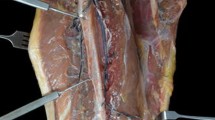Summary
An anatomical study on the blood sources and vascularity of the flexor digital tendon was conducted in the upper extremities of fresh cadavers by means of arterial injection and meticulous dissection of the transparent tendon under the microscope. According to whether or not synovial membrane surrounded the tendon, the flexor digital tendon can be divided into 2 regions: non-synovial and synovial. The major intrinsic blood supply of the digital tendon was in the form of longitudinal vascular bundles, while the transverse anastomotic branches were short and sparse. The non-synovial region of the tendon was covered by paratenon and the vascular distribution of this region was uniform. In the synovial sheath, the blood vessels distributed only on the dorsal side, while the volar side was devoid of vessels. The profundus and superficialis tendons had an avascular zone at the proximal interphalangeal and metacarpophalangeal joints respectively. It was considered that the difference of the vascular architecture might be related to the mechanical force to which the tendon was subjected. The nutrition of tendon was discussed and the selection of tendon graft at operation was suggested.
Résumé
Une étude anatomique des pédicules et de la vascularisation des tendons fléchisseurs des doigts a été réalisée sur cadavres frais, au moyen d'injections artérielles d'encre de chine, et d'une dissection méticuleuse sous microscope du tendon diaphanisé. Selon que la membrane synoviale entoure ou non le tendon, ce dernier peut être divisé en deux parties: partie non synoviale et partie synoviale. La vascularisation intrinsèque du tendon fléchisseur digital est essentiellement constituée par des éléments vasculaires longitudinaux, tandis que les anastomoses transversales sont courtes et éparses. La partie non synoviale du tendon est enveloppée par le paratendon et la distribution vasculaire dans cette région est uniforme; dans la gaine synoviale les vaisseaux sanguins se distribuent seulement du côté dorsal, tandis que le côté palmaire est dépourvu de vaisseaux. Les tendons fléchisseurs superficiels et profonds présentent une zone avasculaire au niveau des articulations interphalangienne et métacarpophalangienne. On peut penser que la différence d'architecture vasculaire peut être en relation avec les forces mécaniques auxquelles le tendon est soumis. Le mode de nutrition du tendon est discuté et le choix d'une greffe tendineuse en per-opératoire est suggéré.
Similar content being viewed by others
References
Bergtjung L (1968) Vascular reactions after tendon suture and tendon transplantation. Scand J Plast Reconstr Surg 4: 7–63
Brockis JG (1953) The blood supply of the flexor and extensor tendons of the fingers in man. J Bone Joint Surg 35: 131–138
Chaplin DM (1973) The vascular anatomy within normal tendons, divided tendons, free tendon grafts and pedicle tendon grafts in rabbits. J Bone Joint Surg [Br] 55: 369–388
Edwards DAW (1946) The Blood supply and lymphatic drainage of tendons. Anatomy 80: 147–152
Eiken O, Lundborg G (1983) Experimental tendon grafting within intact tendon sheath. Scand J Plast Reconstr Surg 17: 127–131
Jishuitan Hospital (1978) Surgery of the hand. 1st Beijing: People's Health Publishing House, pp 79–82
Lundborg G (1976) Experimental flexor tendon healing without adhesion formation — a new concept of tendon nutrition and intrinsic healing mechanisms. Hand 8: 235–238
Matthews P (1976) The fate of isolated segments of flexor tendons within the digital sheath — a study in synovial nutrition. Br J Plast Surg 19: 216–224
Smith JW (1965) Blood supply of tendons. Am J Surg 109: 272–276
Yang KF (1983) The results of free grafts in flexor tendon of the finger. Chin J Orthop 6: 327–330
Zhang Z-Z, Zhong S-Z, Sun B (1989) Applied anatomic observation on the synovial membrane of digital sheath. Chin J Surg 7: 209–210
Author information
Authors and Affiliations
Rights and permissions
About this article
Cite this article
Zhang, ZZ., Zhong, SZ., Sun, B. et al. Blood supply of the flexor digital tendon in the hand and its clinical significance. Surg Radiol Anat 12, 113–117 (1990). https://doi.org/10.1007/BF01623335
Received:
Accepted:
Issue Date:
DOI: https://doi.org/10.1007/BF01623335




